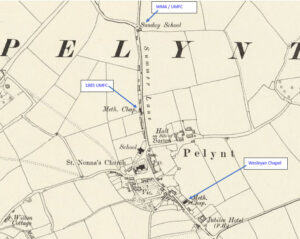
The profiles of Pelynt Methodist Chapels have been compiled by Jo Lewis and Tony Mansell.
1814 Wesleyan Chapel
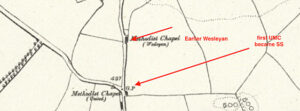 The Wesleyan Chapel shown here is thought to be the one at Shufflers Hole. It is shown on this 1840s-1880 map but no longer marked as such on 1888-1913 maps although the building was extant.
The Wesleyan Chapel shown here is thought to be the one at Shufflers Hole. It is shown on this 1840s-1880 map but no longer marked as such on 1888-1913 maps although the building was extant.
1814: The first chapel was built at Shufflers Hole, though, as its name implies, it was neither a convenient nor popular location. (A Short History Of Methodism In Pelynt. Centenary Issue by P.Bowden. Printed for Pelynt Methodist Church at the Carpenters Press, Common Moor) / Joanna Mattingly)
When in 1837, the Wesleyan Association broke away, they built their own chapel “defiantly within sight of the original one”. (A Short History Of Methodism In Pelynt. Centenary Issue by P.Bowden. Printed for Pelynt Methodist Church at the Carpenters Press, Common Moor) / Joanna Mattingly.
1888: The Wesleyans moved direct from Shufflers Hole to the 1888 Wesleyan Chapel.
The building was demolished, however there are buildings there, hidden behind trees and a large gate marked private.
Trelawne Mill Wesleyan Chapel
Trelawne Mill is just north and east of Trelawne House – east of Pelynt. Taking the Beacons from the B3259, follow the road east and it lies on the north side of the road before the junction with the Duloe road.
1885: Build date. (Kellys 1902)
The chapel is concurrent with the 1888 one below, probably because Trelawne is some distance from the village.
It is marked on 1888 maps simply as a chapel.
1932: The Wesleyan, Primitive Methodist and the United Methodist Church amalgamated to become the Methodist Church of Great Britain.
1932: Became Trelawne Mill Methodist Chapel.
Trust accounts for 1885-1946 exist.
1948: The Chapel was sold.
Trust minutes for 1922-1948 exist.
1948: Correspondence and accounts concerning the sale of the chapel exist.
“One of the Pelynt chapels, Trelawne Mill, ended its days as a fertiliser store.” (A Short History Of Methodism In Pelynt. Centenary Issue by P.Bowden. Printed for Pelynt Methodist Church at the Carpenters Press, Common Moor) / Joanna Mattingly.
1888 Wesleyan Chapel
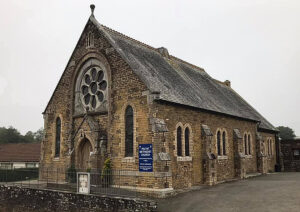 (Photo: Barry West)
(Photo: Barry West)
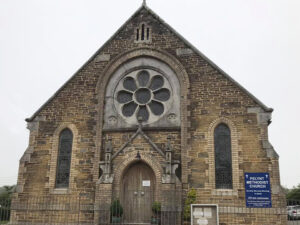 (Photo: Barry West)
(Photo: Barry West)
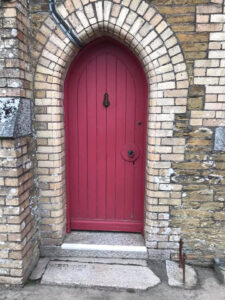 (Photo: Barry West)
(Photo: Barry West)
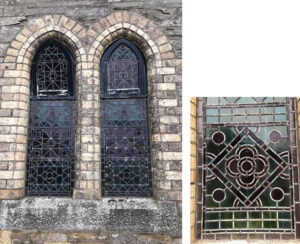 (Photo: Barry West)
(Photo: Barry West)
Methodist chapel. Late C19. Killas rubble with brick and freestone dressings; steep dry Delabole slate roofs with crested ridge tiles. Gothic style with rose window over gabled doorway. Unaltered buttressed elevations with lancets with coloured leaded glass. (Heritage Gateway)
Located to the south of Pelynt, on Jubilee Hill,
Not marked on 1873-1888 map.
Built as a Wesleyan Chapel, with a Sunday school as part of the building, there are records from 1897.
“This was the long overdue replacement for Shufflers Hole.” (A Short History Of Methodism In Pelynt. Centenary Issue by P.Bowden. Printed for Pelynt Methodist Church at the Carpenters Press, Common Moor / Joanna Mattingly)
1888: “Pelynt New Wesleyan Chapel. The Wesleyan Society of Pelynt have long felt the necessity of providing a seemlier and more convenient place of worship. The existing building is antiquated and dilapidated, situated in an obscure position in a by-road at an inconvenient distance from the village. The difficulty of procuring a suitable site delayed the work for a considerable time but it was ultimately overcome by Mr. T. Northcott, who, on purchasing a freehold garden in the village, generously gave the land on which the new premises are to be erected. The chapel, which will occupy quite a prominent position just at the entrance of the village, is a neat, well-proportioned Gothic structure, designed by Mr. Hicks, architect, of Redruth, and when completed will be an ornament to the village. The estimated cost, exclusive of site, is about £600, and the contractors for masonry are Messrs Lean and Coss and for carpentry Mr. S. Slade. In connection with the memorial stone laying, the services on Thursday were well attended; friends from many parts of this circuit by their presence shewing their sympathy with the work…” (Royal Cornwall Gazette – Thursday 11 October 1888)
1889: “Pelynt New Wesleyan Chapel. The Wesleyan chapel which has just been erected at Pelynt, near Looe, was opened on Thursday, and the weather being beautifully fine, the day’s proceedings were well patronised. The chapel, which is 60 feet long and 31 feet wide, and includes a schoolroom, has been erected by Messrs. Lane and Cross, of Looe (masons), and Mr. Slade, Pelynt (carpenter), from designs prepared by Mr. James Hicks, Redruth… Mr. Northcott explained the circumstances which led to the erection of the new chapel. The old chapel had got into such a dilapidated state as to be almost unsafe for the holding of services, and in 1887 they secured, by purchase, the site on which the new building stood. In March of last year operations were commenced, and their friends came forward very readily to help them. The foundation-stone was laid in October last…” (West Briton and Cornwall Advertiser – Thursday 25 July 1889)
The Comprehensive Gazetteer of England & Wales, 1894-5 notes the presence of Wesleyan and Methodist Chapels in the village.
On 1900s map it is marked simply as a Methodist Chapel.
Kellys 1902 notes a Methodist Association and Wesleyan in the village and describes this chapel as built in 1889 at a cost of £600.
1920s: Merged with the United Methodist Free Chapel (Summer Lane Chapel).
1932: The Wesleyan, Primitive Methodist and the United Methodist Church amalgamated to become the Methodist Church of Great Britain.
1932: Became Pelynt Methodist Church. (SW Churches)
1935: Greater Efficiency Increased Power. “I Imagine if those great Methodists, in whose minds the idea of union took shape could be present today and could behold the healthy prospects and the prosperous signs here, they would feel they had not lived in vain. Their aim. unless I mistake it. was for greater efficiency and increased power. That end should be gained and experienced in Pelynt. It Is up to you to see to It that it is gained, that because of this union there is greater efficiency and greater power. Thu building which you have had renovated is undoubtedly the best, for want of a better word, I am going to say chapel here in the village. In Pelynt the United Methodists had the best congregations and the Wesleyans the best chapel, and what more fitting than that the best building should he retained and the congregations amalgamated Into one. This chapel has been renovated and will accommodate the congregations of both churches. It Is in an excellent condition; you have had installed an up-to-date heating apparatus and a tuneful organ…” (Cornish Guardian – Thursday 2 May 1935)

